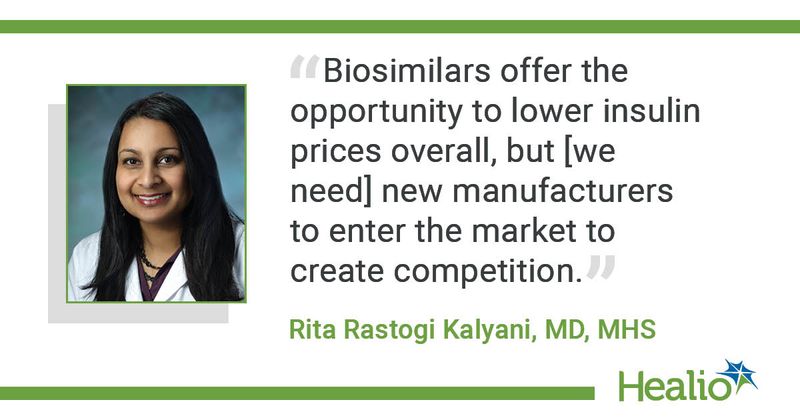Developing more biosimilar insulins could reduce costs for people with diabetes
NEW ORLEANS — Biosimilar products could reduce the cost of insulin for people with diabetes, but more manufacturers must enter the market to create competition and allow cost savings to be realized, according to a speaker.
“As the price of insulin continues to rise, individuals with diabetes are often forced to choose between purchasing their medications or paying for other necessities,” Rita Rastogi Kalyani, MD, MHS, associate professor of medicine in the division of endocrinology, diabetes and metabolism at Johns Hopkins University School of Medicine, said during a presentation at the American Diabetes Association Scientific Sessions. “Newer insulins, including analogs, represent 80% of insulin visits and are more expensive than older insulins, including human insulins. Biosimilars offer the opportunity to lower insulin prices overall, but the manufacturing process is still cumbersome and requires new manufacturers to enter the market to create competition.”

Most Americans use analog insulin
The cost of insulin has gradually increased over time in U.S., likely due to the increased use of analog insulins, Kalyani said. In 2017, the estimated cost per vial of the insulin analog Lantus (Sanofi) was $178 in the U.S. compared with $25 for the human Novolin N insulin (Novo Nordisk).
A study published in JAMA Network Open in 2021 examined trends in insulin use and insulin treatment visits in the U.S. from 2016 through 2020 for adults aged 35 years or older with type 2 diabetes. Analog insulin was overwhelmingly the most-used type of insulin in the study, with 92.7% of adults using analog insulin in 2016 and the percentage remaining high at 86.3% in 2020. Kalyani said the majority of insulins used were insulin glargine during the study.
The use of biosimilar insulin slowly increased each year during the study but remained low with less than 10% of adults using a biosimilar product each year. The percentage of adults prescribed a biosimilar insulin peaked in 2020 at 8.2%. Human insulin use dropped from 7.3% in 2016 to 5.5% in 2020.
A pair of studies suggest increased use of biosimilar insulin may lower the costs for consumers. One study conducted in Canada found there was a large projected potential cost savings with use of the biosimilar insulin Basaglar (Eli Lilly) compared with its originator, Lantus. Additionally, a research letter published in JAMA found the introduction of biosimilar insulin was associated with less reimbursement by Medicaid per milliliter of insulin, suggesting greater competition in the market was associated with lower insulin costs.
Hurdles for development
The regulatory framework for developing and approving biosimilar insulins may be burdensome for manufacturers, according to Kalyani. Before 2020, biosimilar insulins were approved as follow-on insulin through an abbreviated pathway under the Federal Food, Drug and Cosmetic Act. As Healio previously reported, the FDA announced a new regulatory pathway in March 2020 allowing certain products, including biosimilar insulin, to become officially regulated as biological products. The change was made to better facilitate the development of biosimilars.
Kalyani said pharmacists can automatically substitute reference drugs with their respective, small-molecule generic drugs without contacting the prescriber if the substitute is deemed interchangeable by the FDA. In practice, however, there is still debate over whether a pharmacist should automatically substitute an interchangeable biosimilar for insulin. In a study published in the Journal of Diabetes Science and Technology, 85.9% of providers said they would prefer to be notified prior to their patient being switched to a biosimilar insulin.
As Healio previously reported, the FDA approved its first interchangeable biosimilar insulin, insulin glargine-yfgn (Semglee, Mylan), for use with the reference product Lantus, in July 2021. In December 2021, a second biosimilar, insulin glargine-aglr (Rezvoglar, Eli Lilly), was approved for use as a substitute for Lantus. However, according to a report from the ADA Insulin Access and Affordability Working Group published in 2018, more biosimilar products must be developed for cost savings to be realized.
“There are not enough biosimilar insulins on the market,” Kalyani said in reading from the ADA Insulin Access and Affordability Work Group’s recommendations. “Prices for biosimilar insulins are not likely to be lower unless there are multiple biosimilars that can be substituted for the brand-name analog insulin, rather than only one.”
References:
- Cefalu WT, et al. Diabetes Care. 2018;doi:10.2337/dci18-0019.
- Dolinar RO, et al. J Diabetes Sci Technol. 2014;doi:10.1177/1932296813518267.
- Hernandez I, et al. JAMA. 2019;doi:10.1001/jama.2019.2990.
- Mansell K, et al. BMC Health Serv Res. 2019;doi:10.1186/s12913-019-4680-2.
- Sarkar S, et al. JAMA Netw Open. 2021;doi:10.1001/jamanetworkopen.2021.28782.


